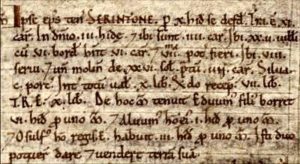Sherington is recorded in the Domesday Book in 1086 as ‘Serintone’.
Translation

“The bishop holds Serintone himself. It is assessed at 10 hides. There is land for 11 ploughs. In the demesne are 3 hides and on it are 4 ploughs. There 22 villeins with 6 bordars have 6 ploughs and there could be a seventh. There are 8 serfs and one mill worth 26 shillings, meadow sufficient for 4 plough teams and woodland to feed 100 swine. In all it is worth 10 pounds; when received 7 pounds; TRE 10 pounds. Here Edwin, son of Borred, held 6 hides as one manor and his man, Alwin, one hide as another, and Oswolf, a man of King Edward, 3 hides as a third manor. These two could give and sell their land.”
Notes
The bishop is Geoffrey de Mowbray, the bishop of Coutances.
Villeins and bordars were the two classes of peasant, whereas serfs were not free.
The value of the mill (26 shillings) was more than any other in Buckinghamshire, indicating its relative importance and size.
TRE stands for ‘Tempora Regis Eduardis’, ie at the time of King Edward the Confessor (in other words, before 1066). The 30% reduction in value after the Norman Conquest may have been the result of destruction caused by the invading army. However, it is also possible that the loss had been caused by the Danes, who raided the area from their base in Northampton in 1065.
Borred (also known as Burghaed) held 31½ hides in north Bedfordshire and about the same number of hides in Northamptonshire, as well as Olney (10 hides), Weston Underwood (7½ hides) and Lavendon (5¾ hides) in Buckinghamshire. His son Edwin held 17 hides in Lathbury, as well as the 6 in Sherington. Edwin was allowed to keep 1½ virgates of land in his own Northamptonshire village of Stanion as an undertenant of the bishop. A ‘virgate’ is a quarter of a hide, or approximately 30 acres.
A ‘hide’ is approximately 120 acres and was used as a measurement of how much tax (or ‘geld’) was to be paid. A ‘plough’ team would have had 8 oxon. This suggests that the area under cultivation was of the order of 1320 acres (840 in the open fields and 480 is the demesne), whilst the size of the woodland indicates that le Hoo Park (the area south-east of Perry Lane) was still woodland.
Information taken from AC Chibnall’s book “Sherington, Fiefs and Fields of a Buckinghamshire Village”.
